 Leading Blog | Posts by Month |
 Leading Blog | Posts by Month |
12.31.10

LeadershipNow 140: December 2010 Compilation
Posted by Michael McKinney at 10:03 AM
12.30.10

5 Leadership Lessons: Artistry Unleashed Related Interest:
Posted by Michael McKinney at 12:53 AM
12.29.10

Leadership: Artistry Unleashed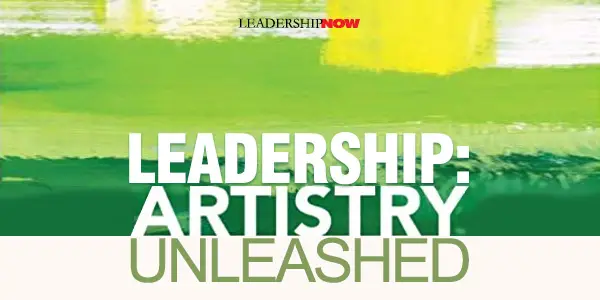
The executive functions … are feeling, judgment, sense, proportion, balance, [and] appropriateness. It is a matter of art rather than science, and is aesthetic rather than logical.Leadership is an art. But what does that really mean? Leadership can be taught in the way that art can be taught. There are techniques and principles that need to be understood. Seeds that can be planted. But ultimately it has to be practiced and experienced. There is the part that really matters, as Georges Braque observed, that can’t be explained. That is the art; the ever-changing context of leadership and the dance between leaders and followers that molds and shapes both the leader and follower. There is an art to bringing leadership teaching into the nuance of life. Leadership practiced, is artistry unleashed. Hilary Austen does a masterful job of explaining, even if indirectly, the art of leadership in Artistry Unleashed. She takes design thinking beyond the surface concerns of practical design and to the processes behind it. These are important issues for leaders as we face what Austen terms enigmatic problems: those that push us to the edge of what we know. “Our best solutions to such problems lie not just in better analytical tools but in a fundamentally different approach to our work—an approach that follows from cultivating qualitative intelligence in our given profession or medium.” Any more quantitative approaches alone won’t work. She explains the difference: “Quantitative thinking allows us to be precise and to share understanding; we use it to define fairness and rationality and effectiveness. It’s this utility that has led so many people to equate quantitative thinking with intelligence.” “A qualitative approach embraces the unexpected, the subtle, the open-ended, the unique, the poetic; it escapes rules, single answers, or single perspectives. These features are by their very nature hard to pin down and can be quite unnerving to people who want precise information and specific answers. The quantitative approach gives us the means to predict and control what we can measure, to record and codify what can be clearly defined, to collect sharable facts, and to identify universal rules and laws. To be sure, Austen is not advocating one or the other. “Each has its own set of purposes, and developing one does not mean abandoning the other. Achieving artistry means being able to use qualities to help you work when that’s what the situation demands; it doesn’t mean rejecting quantitative methods.” We gravitate to quantitative thinking. We like things nailed down. Numbered. Labeled. Defined. It gives us some certainty. It makes us comfortable. We can check it off and move on confident that we’ve done the “right thing.” Unfortunately, life is messier than that. Austen cites Ted Sorenson’s observation from his book Decision-Making in the White House: “White House decision-making is not a science but an art. It requires not calculation but judgment….Every decision a president makes involves uncertainty.” Qualitative thinking is less about imposing an answer and more about shaping an answer from awareness of the present and feedback from the application of knowledge to it, when predetermined steps and measurable goals are absent. The present and the possible are considered at the same time so that ends and means influence each other as they occur. Austen writes, the “interdependent relationship between ends and means is a hallmark of artistic work. As your effort to solve an enigmatic problem proceeds, the ends evolve as means are generated. Likewise, as means unfold, new ends become possible; these may, in turn, demand new means.” It means managing the tension between mastery and originality in search of the possible. “The forces that drive mastery are conservative. Mastery brings predictability and control to action. By contrast, originality is driven by often unpredictable responses to immediate experience. Finding originality means leaving behind some of what you know. Artistry is driven forward by the interplay of these two competing forces.” New York University professor David Ecker’s six phases of qualitative problem solving developed from the work of John Dewey, described in Artistry Unleashed by Austen is helpful: In the first phase, artists engage what Ecker calls the presented or initial relationship between existing qualities….Some of these relationships may be problematic, others intriguing, and so they attract the artist’s attention. Different practitioners may see different qualities and make sense of what they see differently, depending on the ideals, concepts, and sensibilities they bring to bear on the situation.A leader’s function is to create the disequilibrium needed to go from the known to the unknown possibilities. Qualitative thinking is important to the leader because without it we can easily impose answers rather than exploring possibilities. We can too, get in our own way by overvaluing the importance of our own experience and thought and thereby limit possible outcomes. Austen develops a Knowledge System model comprised of the interdependency of Experiential Knowledge, Conceptual Knowledge, and Directional Knowledge, that can be used to help anyone develop and apply qualitative thinking. The cursory view I present here of the connection between business and art, she more fully develops in her book. The examples she gives dramatically demonstrate this important connection and essential understanding needed by leaders of every type. Related Interest:  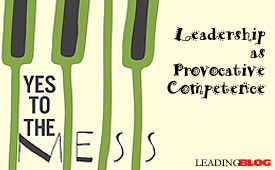 
Posted by Michael McKinney at 01:21 AM
12.28.10

Leading Views: Being an Insider and an Outsider “The power of being simultaneously an insider and an outsider.” ~Dov Frohman
“The power of being simultaneously an insider and an outsider.” ~Dov Frohman
Think about it. Flexibility. Freedom. Insight. Dove Frohman wrote in Leadership the Hard Way: “Unless you are prepared to see things differently and go against the current, you are unlikely to accomplish anything truly important. And to go against the current, you have to be something of an outsider, living on the edge, a member of a small but vibrant counterculture.” He adds, “You must free yourself from habitual ways of looking at things, cultivate an independent and questioning perspective, and be ready to embrace alternative and counterintuitive points of view.” What is your standard deviation? Related Interest:
Posted by Michael McKinney at 12:40 AM
12.27.10

“If they do that, I don’t consider them a leader.”We need to get over the notion that a leader is a perfect person with a set of qualities that are balanced and in perfect alignment. And to be less makes you, you know … a manager. If that were the case we might as well forget about being a leader. We’re just not up to it. And yet life goes on and people do lead—in spite of themselves. And their humanity gives us all hope that we too can lead, influence, have an impact, and create meaning.A good leader is a person that knows their weaknesses, makes (sometimes really stupid) mistakes, admits them, makes an effort to do better, and moves on. In spite of their own inadequacies they jump back in every day and work for a cause bigger than themselves. The challenge is not in avoiding mistakes; it is in knowing how to deal with them when they are made. A good leader knows they can’t do it on their own. They have limitations. They need the support and effort of those around them. In fact, they put people on their team specifically because they are lacking in one area or another. A leader doesn’t let their weaknesses hold them back. A good leader understands that leadership development is a life-long process of continual learning; continual improvement. Being a leader isn’t a place you arrive at. It’s is something you grow into and grow with if you are going to be effective. Leadership without growth is not sustainable. If you are in it for the long-term, you have to be teachable, not perfect. Perfection doesn’t qualify you as a leader, but knowing what to do about your inadequacies, foibles, quirks, weaknesses, and blunders makes it possible.
Posted by Michael McKinney at 12:19 AM
12.25.10

Best Leadership Books of 2010
A crisis exposes character or the lack of it. Our reaction is important. Our recent history requires a response; a correction; a change in the status quo. If we are thinking more-of-the-same or merely upping our game then we are destined to fail again. On the other hand if we are looking to change our games or approach, then we have a way forward. The way forward will mean reviewing a lot of overly familiar ideas like, “self-awareness is critical to a good leader” because those are the things we forgot or were maybe never taught. While books about these ideas can seem boring they can, if we let them, take us to a higher level. But they require introspection and often more attention than we may think we have time for. But what is the alternative? As reading goes, the books listed here may not be as exciting as how-can-I-leverage-other-people’s-money nor are they going to be paradigm-shifting as in why-hasn’t-somebody-thought-of-this-before. However, while many of the ideas are not new, they can be life-changing. Some of the books listed below help to reacquaint us with ideas that we might have consciously or unconsciously decided that we would get back to when we had the time. Others help us to better understand the connected world we live in. One helps to explain the artistry of leadership. Some, while exploring the lives of others, help to provide a context for all of it. The big lesson for all of us: nothing—leadership, capitalism, society—can be sustained forever in a culture of get—with a mindset of always more. But that’s a tough lesson to act on. When faced with the daily business of life, the ideas of give and service seem so vapid—intangible—naive. Give. Easy to say. Much harder to live. 
Biographies: Related Interest:
Posted by Michael McKinney at 06:03 PM
12.24.10

Are Your Goals HARD Enough?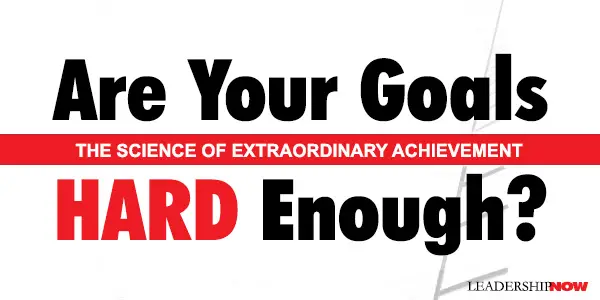
ACCORDING to research by John C. Norcross, a clinical psychologist at the University of Scranton in Pennsylvania, only about 45 percent of the subjects managed to stick to their resolutions after six months, and, after a year, that number declines to around ten percent. It’s as Oscar Wilde wrote: "A New Year's resolution is something that goes in one year and out the other.'' The problem, says Leadership IQ CEO Mark Murphy, is that we are trying to execute goals we don’t really care about. The kinds of goals that lead to success “stimulate the brain in profoundly different ways than the goals most people set. In nearly all cases where greatness is achieved, it’s the goal that drives motivation and discipline—not the other way around.” He reports in Hard Goals that in a recent study of over 4000 workers, only 15 percent of them believed that their goals for this year were going to help them achieve great things. And only 13 percent thought their goals would help them maximize their full potential. The solution, says Murphy, is to create H.A.R.D. goals—targets that are:Heartfelt—you’ve got to have an emotional attachment to your goal; it has to scratch an existential itch; you have to develop a heartfelt connection to the payoff.
Every goal you set needs to pass these four tests. Murphy devotes a chapter to each of these four tests. “The overwhelming majority of human beings have tremendous untapped potential but there’s nothing pushing them to access it. Setting goals that are difficult helps unleash the depth of that potential.” Especially helpful is the chapter on the Required part of HARD goals and the need to “alter your view and value of future payoffs so they become more attractive than what the status quo is offering today. You can intentionally move some of the immediate costs of your goal into the future in order to sync up the costs and benefits. Or, conversely, you can bring some of your goal’s future benefits into the present. Both will make your goal look a whole lot more attractive and amp up your urgency to get going on it now.” Inevitably you ask, “Where do I begin once I have my HARD goal?” Murphy suggests you work backwards. First determine the timeframe for your goal—say a year. Then cut it in half and ask, “What must I have accomplished at the six-month mark in order to know that I’m on track to achieve the full HARD Goal?” Then cut that in half and ask, “What must I have accomplished at the three-month mark in order to know that I’m on track to achieve all of my six-month targets?”Continue to cut the time in half until you get to one week and then ask yourself, “What must have I have accomplished today in order to know that I’m on track to achieve all of my one-week targets? Breaking your HARD Goal down into identifiable steps will first, show you exactly where to start. “Second, it monitors and keeps you on track to achieve your HARD Goal (and intensify your efforts where necessary). And third, this exercise shows you that every single day needs to contain some activity in pursuit of your HARD Goal.” Try it this coming year! 
Posted by Michael McKinney at 08:02 AM
12.23.10

Managing Yourself First Checklist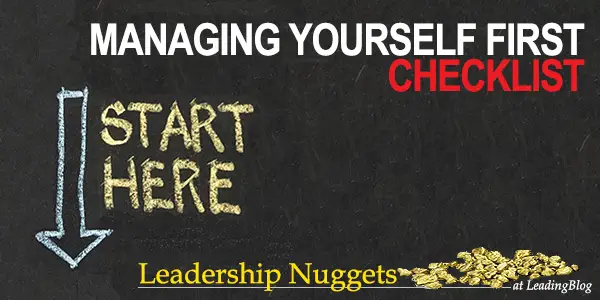
MAKE sure that the first person you are managing every day is yourself. Take good care of yourself outside of work so that you can bring your best self to work every day. Arrive a little early to work and stay a little late. Focus on playing the role assigned to you before trying to reach beyond that role. Focus on doing your tasks, responsibilities, and projects very well, very fast, all day long. If you want to carry weight with your boss, that should be your primary focus. Be a problem-solver, not a complainer. Commit to continuous improvement through rigorous self-evaluation. Think about context and figure out where you fit in every situation. Continually ask yourself, “Where do I fit in this picture? Why am I here? What is at stake for me? What is my appropriate role in relation to the other people in the group? What is my appropriate role in relation to the mission?” Concentrate on playing these roles 110 percent. Contribute your very best thoughts, words, and actions. No matter how lowly or mundane or repetitive or minor your tasks and responsibilities might seem in relation to the overall mission, play your role to the max. Attitude matters—a lot. Effort matters—a lot. Start mastering the art of human relations. Approach every relationship by focusing on what you have to offer the other person rather than on what you might want or need. Be a model of trust. Remove your ego. Listen carefully. Empathize. Exhibit respect and kindness. Speak up and make yourself understood. Be a motivator. Celebrate the success of others. Make yourself a great workplace citizen. Under-promise and over-deliver. Don’t bad mouth others, and try not to speak about others unless they are present. Keep your word. Keep your confidences. Be an accurate source of information. Don’t keep other people waiting. Instead of under-dressing, overdress. Practice old-fashioned good manners. Adapted from It’s Okay to Manage Your Boss by Bruce Tulgan. 
Posted by Michael McKinney at 08:13 AM
12.22.10

Are You Undermanaged?
BBRUCE TULGAN thinks that at every level of organizations there is a shocking and profound epidemic of undermanagement. That’s right undermanagement. In It’s Okay to Manage Your Boss he argues: The vast majority of supervisory relationships between employees and their bosses lack the day-to-day engagement necessary to consistently maintain the very basics of management: clear expectations, necessary resources; real performance tracking; and fair credit and reward. In fact, most employees report that they feel disengaged from their immediate boss(es); that two-way communication is sorely deficient; and that employees rarely get the daily guidance, resources, feedback, and reward that they need.Part of the problem is that all too often, people are promoted to management positions not because if their people skills, but because of their competency in one area or another. Consequently, they fail to lead, manage or supervise on a daily basis. But what about micromanaging? Tulgan says that what is often labeled “micromanagement” is really a consequence of not managing well. For example, if a manager asks an employee to check in every step of the way in order to complete simple tasks, “it is most always because the manager has not prepared the employee in advance” to able to make those simple decisions. Proper management means making sure that the employee understands how to carry out the task and responsibilities, and is equipped with the necessary tools and skills to do so. It’s Okay to Manage Your Boss is written for undermanaged employees. If the manager isn’t doing it, Tulgan says it is up to the employee to manage the boss. He writes, “In order to be a high-performer in today’s workplace, you need to create highly engaged relationships with every boss, whether that boss is great, awful, or somewhere in between.” Undermanagement is for low-performers. He lays out a seven step plan to manage your boss beginning with learning to manage yourself first. Tulgan urges us to take responsibility for our part of the management relationship. Are you undermanaged? And as a leader, are you paying attention to management basics: providing direction and guidance, holding people accountable, dealing with failure, and rewarding success? 
Posted by Michael McKinney at 12:30 AM
12.21.10

quickpoint: The Benefits of Hardship in Character Development Adversity and hardship contribute to character development when they cause personal reflection and introspection about a leader’s behavior and influence. Hardship can cause leaders to look inside themselves, asking questions the answers to which can result in huge learnings and behavioral adjustments. Hardship can reveal a leader’s behavioral blind spots, inconsistencies, weaknesses, personal limitations, ad ineffective or bad behaviors. Adversity and hardship contribute to character development when they cause personal reflection and introspection about a leader’s behavior and influence. Hardship can cause leaders to look inside themselves, asking questions the answers to which can result in huge learnings and behavioral adjustments. Hardship can reveal a leader’s behavioral blind spots, inconsistencies, weaknesses, personal limitations, ad ineffective or bad behaviors.
Hardship and adversity can also be cleansing. They can have a refining effect. Through suffering, the dross of one’s personality can be removed. It can cause a leader to look at personal behavioral challenges related to anger, impatience, fear, selfishness, and so on. Adversity can also produce a clearer focus and concentration on what is important in life and what is not. There is also a maturing element to hardship. Mature means being seasoned, tested, hardened, weathered, ready, and fully developed. Thus, adversity and hardships can take each of us to a higher level of character development. (Adapted from: Building Character: Strengthening the Heart of Good Leadership by Gene Klann)
Posted by Michael McKinney at 08:45 AM
12.20.10

Bill Cohen’s Eight Universal Laws of Heroic Leadership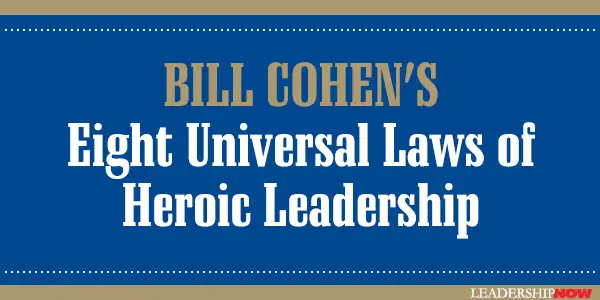
BILL COHEN says “Heroic leadership is special. It requires leading a group with absolute integrity while raising individual performance to a personal best and building a team spirit of sacrifice for the common good,” and adds, “heroic leadership requires tough standards.” Cohen correctly states in Heroic Leadership, that “we cannot lead on automatic.” It takes “considerable thought, intention, and action.” He believes that good leadership must be grounded in the following eight principles of heroic leadership:

Posted by Michael McKinney at 01:54 AM
12.16.10

5 Leadership Lessons: Finding the Right Leader The failure rate of executive transitions—up to 40 percent of all leaders fail in their new roles and are replaced or retired in their first eighteen months on the job—is one of the costliest problems any organization can face. In The Right Leader, executive career advisor Nat Stoddard and Claire Wyckoff present a process to improve the search for top-level executives. While most selection processes evaluate the candidate’s ability and personality in addition to the company’s needs, they don’t go far enough. Stoddard points out that three other areas need to be considered: the candidates energy and character, and third, the organizations culture. The authors suggest ways to evaluate these additional areas. The thoughts they provide offer lessons for all leaders:
Posted by Michael McKinney at 11:33 PM
12.13.10

Bury My Heart at Conference Room BIn Bury My Heart at Conference Room B, Stan Slap cuts through a lot of the dancing around that occurs in many leadership discussions.It should go without saying that emotional commitment improves organizational performance. If in doubt, Slap spells it out in the first third of the book. The way to get that emotional commitment, says Slap, is for you to live your own deepest values in your work environment. While any organization should encourage this, most often they don’t. “What companies want most from their managers is what they most stop their managers from giving. What managers want most from their jobs is what they most stop themselves from doing.” So, it’s up to you. The process of managing this tension what Bury My Heart is all about. The underlying problem is this: Companies can’t get emotional commitment from their managers because the company believes it needs to be the dominant organism in the relationship, which causes managers to have to repress their own values—and so causes them to detach emotionally from their jobs.Fear drives this tension: Are we going to survive as an organization if we are not in control? Slap says the only sustainable solution is leadership. “Leaders are people who live their deepest personal values without compromise” and because they do, “they’re essentially self-medicated—the pressure’s off the company to provide the deepest motivational fulfillment.” Slap insists that this isn’t licensing chaos but insuring control. Paradoxically, “there is no more reliable way for the company to become the cause than by not always insisting on being the cause.” Allow people to live their values at work. This isn’t a self-indulgent free-for-all. “Freedom to pursue your values come with responsibility to protect the company’s values.” It becomes an issue of trust between the organization and the individual. “Your job as a manager requires achieving results through others. Leadership is the single best method to do that. As long as your vision doesn’t violate the basic objectives and principles of your organization, those results will be hard for anyone to argue with.” Your leadership begins by understanding your own values—what is important to you—so you can sell those values to others. Beyond envisioning a “Better Place” of your creation, the people you lead have to see it too. What does life look like for them in this Better Place? Help them to get what they want as they head toward the Better Place. Slap writes: = Live better. If they believe it, they’ll do it. Of course, not everyone you lead will have the same values as you, but if you have communicated them well, “they’ll support yours if yours have positive impact for them.” Leadership happens to you as soon as you understand your own values and understand how to enroll others in supporting them. Instead of waiting for a leader you can believe in, try this: Become a leader you can believe in.
Posted by Michael McKinney at 11:47 PM
12.09.10

7 Important Personal Qualities that Build Power IN Power, Jeffrey Pfeffer states that you can “compete and even triumph in organizations of all types, large and small, public or private sector, if you understand the principles of power and are willing to use them.”
IN Power, Jeffrey Pfeffer states that you can “compete and even triumph in organizations of all types, large and small, public or private sector, if you understand the principles of power and are willing to use them.”
For some, power is a bad word. But, without a doubt, power does open doors and provides opportunity. Powerlessness creates its own problems—pettiness, blame, irresponsibility, hopelessness and depression. Pfeffer takes a candid look at power. He has found that those that have obtained power possess not only the will—the drive to take on big challenges—but also the skill—the capabilities required to turn ambition into accomplishment. As part of these two fundamental personal attributes, they also possess seven essential personal qualities that help them amass organizational power and influence: Will: The drive to take on big challenges 1. Ambition “Organizational life can be irritating and frustrating and can divert people’s effort and attention. Ambition—a focus on achieving influence—can help people overcome the temptation to give up or to give in to the organization.” Skill: The capabilities required to turn ambition into accomplishment
Power has a right use and a wrong use. The time to think about power is before you get it. Seneca’s caution that those with great power should use it lightly goes in one ear and out the other if you haven’t first established your personal view of and relationship with power. Nearly everything Pfeffer writes in Power can be taken the wrong way and applied in ways that will eventually cost you power or even derail you. Then, too, it can be applied in constructive and other-focused ways as well. If you execute these power strategies at the expense of others, you’re sowing the seeds of your own destruction. If wisdom isn’t part of your agenda, you will end up where you never intended. Unfortunately, there is very little in modern life that will serve to guide you in meaningful ways. History is littered with lessons from those who have used power to advance selfish agendas. However, if you use it with humility, if you use it to free others to lead, you can build a lasting legacy. Humility resolves the problems posed by power. How you build it is as important as why you are building it. 
Posted by Michael McKinney at 11:25 PM
12.07.10

Opportunity Screams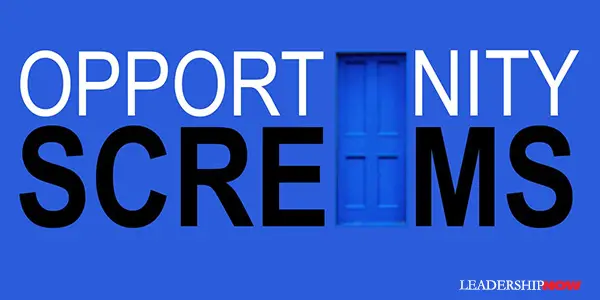 IN Opportunity Screams, Tom Asacker argues that information is no longer power. Power today comes from passion and purpose and the ability to create meaning from information. Through the metaphor of three locked doors—Engagement, Interest and Belief—he develops a framework for unlocking these states of mind in others to attract their attention, sustain their interest, and inspire them to act.
IN Opportunity Screams, Tom Asacker argues that information is no longer power. Power today comes from passion and purpose and the ability to create meaning from information. Through the metaphor of three locked doors—Engagement, Interest and Belief—he develops a framework for unlocking these states of mind in others to attract their attention, sustain their interest, and inspire them to act.
Asacker does not offer a formula to follow. More importantly, he explains the mindset necessary to apply these ideas to your product, service or idea. It really gets back to relationships. He shares a lesson from his father: “It’s all connected. Transparent, honest, caring relationships bring meaning, happiness and growth to your business and to your life.” We are, all of us, at this time, facing a rare opportunity, but to take advantage of it, says Asacker, we must get a thoughtful plan together. “It’s how you frame the situation that will dictate your outcome.” There are no shortcuts. You’ve got to put the time in. It’s not just for marketers, but a must-read for anyone working to influence others. The book also offers links to video extras located on his web site. A brilliant and meaningful idea, even if placed directly in people’s paths, is simply not enough to unlock the Doors to opportunity today. Please don’t delude yourself into thinking that it is. The results will break your heart and your spirit. Passion without understanding eventually burns out. 
Posted by Michael McKinney at 05:32 PM
12.02.10

You’re Not the Most Important Person in the Room
When you are knighted [manager], an invisible sign appears in the center of your forehead and flashes on and off: BOSS … BOSS … BOSS. You can’t see it, but everyone who works for you can. You see lines of people standing around waiting to talk to you. The people who talk to you do it with deference. You notice that your subordinates seem to be concerned about the way they talk to you, but you see no reason why you should be concerned about the way you talk to them. You become aware that when you ask people to do things they do them. After all, they are only there to do your bidding. Quite happily, most of them do so, except the incompetent ones. Because people around you do what you tell them, you become even more impressed with your own importance. But what has happened is that you have become deluded into believing that you are the most important member of that group. Because you believe they need you more than you need them, you treat them accordingly. You get involved in self-destructive behavior. You get lazy and you stop managing; you just keep score. The sad but true fact is that YOU NEED THEM MORE THAN THEY YOU NEED YOU. You can’t get the job done without them. Adapted from Coaching for Improved Work Performance by Ferdinand F. Fournies.
Posted by Michael McKinney at 09:27 AM
12.01.10

First Look: Leadership Books for December 2010Here's a look at some of the best leadership books to be released in December.




For bulk orders call 1-800-423-8273  Build your leadership library with these specials on over 160 titles. All titles are at least 40% off the list price and are available only in limited quantities. "If you want people to read a book, tell them it is overrated." —Nassim Nicholas Taleb
Posted by Michael McKinney at 12:11 AM
|
BUILD YOUR KNOWLEDGE


How to Do Your Start-Up Right STRAIGHT TALK FOR START-UPS 
Grow Your Leadership Skills NEW AND UPCOMING LEADERSHIP BOOKS 
Leadership Minute BITE-SIZE CONCEPTS YOU CAN CHEW ON 
Classic Leadership Books BOOKS TO READ BEFORE YOU LEAD |
|